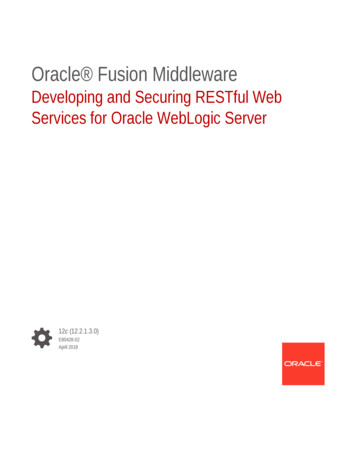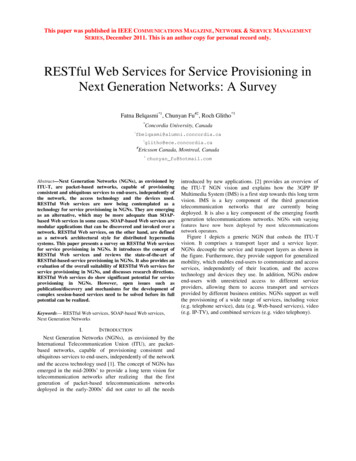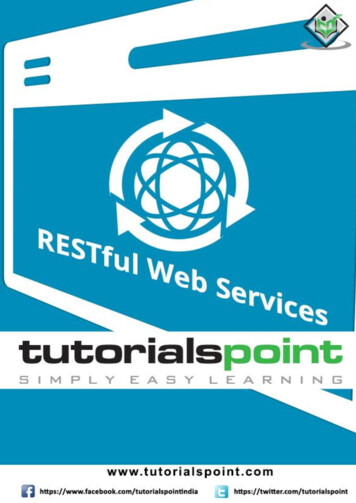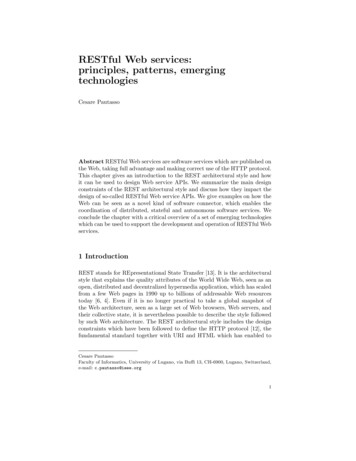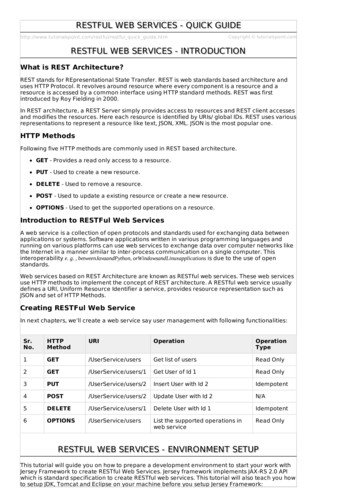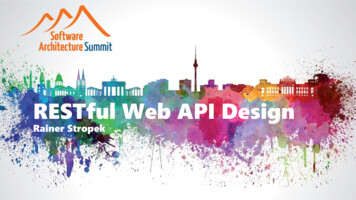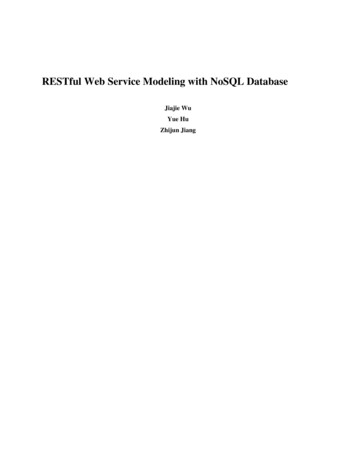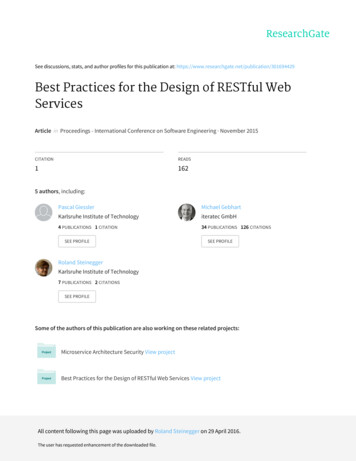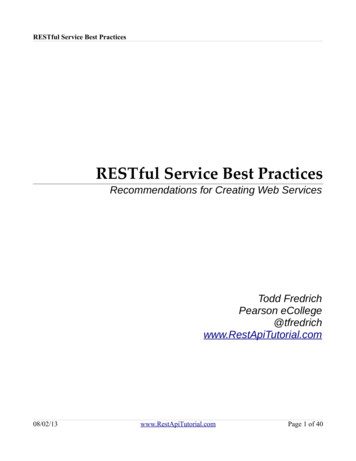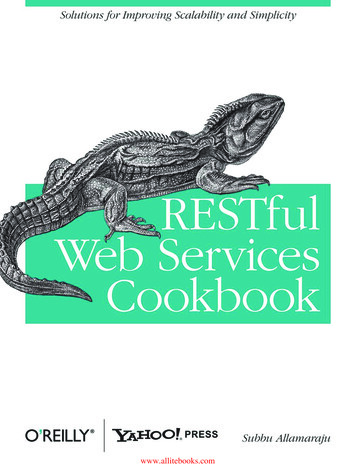
Transcription
www.allitebooks.com
www.allitebooks.com
RESTful Web Services Cookbookwww.allitebooks.com
www.allitebooks.com
RESTful Web Services CookbookSubbu AllamarajuBeijing Cambridge Farnham Köln Sebastopol Taipei Tokyowww.allitebooks.com
RESTful Web Services Cookbookby Subbu AllamarajuCopyright 2010 Yahoo!, Inc. All rights reserved.Printed in the United States of America.Published by O’Reilly Media, Inc., 1005 Gravenstein Highway North, Sebastopol, CA 95472.O’Reilly books may be purchased for educational, business, or sales promotional use. Online editionsare also available for most titles (http://my.safaribooksonline.com). For more information, contact ourcorporate/institutional sales department: (800) 998-9938 or corporate@oreilly.com.Editor: Mary E. TreselerProduction Editor: Sumita MukherjiProduction Services: Molly SharpCover Designer: Karen MontgomeryInterior Designer: David FutatoIllustrator: Robert RomanoPrinting History:March 2010:First Edition.Nutshell Handbook, the Nutshell Handbook logo, and the O’Reilly logo are registered trademarks ofO’Reilly Media, Inc. RESTful Web Services Cookbook, the image of a great fringed lizard, and relatedtrade dress are trademarks of O’Reilly Media, Inc.Many of the designations used by manufacturers and sellers to distinguish their products are claimed astrademarks. Where those designations appear in this book, and O’Reilly Media, Inc., was aware of atrademark claim, the designations have been printed in caps or initial caps.While every precaution has been taken in the preparation of this book, the publisher and author assumeno responsibility for errors or omissions, or for damages resulting from the use of the information contained herein.TMThis book uses RepKover , a durable and flexible lay-flat binding.ISBN: 978-0-596-80168-7[M]1266619255www.allitebooks.com
Table of ContentsPreface . . . . . . . . . . . . . . . . . . . . . . . . . . . . . . . . . . . . . . . . . . . . . . . . . . . . . . . . . . . . . . . . . . . . . ix1. Using the Uniform Interface . . . . . . . . . . . . . . . . . . . . . . . . . . . . . . . . . . . . . . . . . . . . . . 11.11.21.31.41.51.61.71.81.91.101.111.121.13How to Keep Interactions VisibleWhen to Trade VisibilityHow to Maintain Application StateHow to Implement Safe and Idempotent Methods on the ServerHow to Treat Safe and Idempotent Methods in ClientsWhen to Use GETWhen to Use POSTHow to Create Resources Using POSTWhen to Use PUT to Create New ResourcesHow to Use POST for Asynchronous TasksHow to Use DELETE for Asynchronous DeletionWhen to Use Custom HTTP MethodsWhen and How to Use Custom HTTP Headers24791213141618192323252. Identifying Resources . . . . . . . . . . . . . . . . . . . . . . . . . . . . . . . . . . . . . . . . . . . . . . . . . . . 292.12.22.32.42.52.6How to Identify Resources from Domain NounsHow to Choose Resource GranularityHow to Organize Resources into CollectionsWhen to Combine Resources into CompositesHow to Support Computing/Processing FunctionsWhen and How to Use Controllers to Operate on Resources3031323437393. Designing Representations . . . . . . . . . . . . . . . . . . . . . . . . . . . . . . . . . . . . . . . . . . . . . . 453.13.23.33.43.5How to Use Entity Headers to Annotate RepresentationsHow to Interpret Entity HeadersHow to Avoid Character Encoding MismatchHow to Choose a Representation Format and a Media TypeHow to Design XML Representations4649505256vwww.allitebooks.com
3.63.73.83.93.103.113.123.133.14How to Design JSON RepresentationsHow to Design Representations of CollectionsHow to Keep Collections HomogeneousHow to Use Portable Data Formats in RepresentationsWhen to Use Entity IdentifiersHow to Encode Binary Data in RepresentationsWhen and How to Serve HTML RepresentationsHow to Return ErrorsHow to Treat Errors in Clients5859616265666769734. Designing URIs . . . . . . . . . . . . . . . . . . . . . . . . . . . . . . . . . . . . . . . . . . . . . . . . . . . . . . . . 754.14.24.34.4How to Design URIsHow to Use URIs As Opaque IdentifiersHow to Let Clients Treat URIs As Opaque IdentifiersHow to Keep URIs Cool757981835. Web Linking . . . . . . . . . . . . . . . . . . . . . . . . . . . . . . . . . . . . . . . . . . . . . . . . . . . . . . . . . . 875.15.25.35.45.55.65.75.8How to Use Links in XML RepresentationsHow to Use Links in JSON RepresentationsWhen and How to Use Link HeadersHow to Assign Link Relation TypesHow to Use Links to Manage Application FlowHow to Deal with Ephemeral URIsWhen and How to Use URI TemplatesHow to Use Links in Clients8890919395991011036. Atom and AtomPub . . . . . . . . . . . . . . . . . . . . . . . . . . . . . . . . . . . . . . . . . . . . . . . . . . . 1076.16.26.36.46.5How to Model Resources Using AtomWhen to Use AtomHow to Use AtomPub Service and Category DocumentsHow to Use AtomPub for Feed and Entry ResourcesHow to Use Media Resources1081111161181197. Content Negotiation . . . . . . . . . . . . . . . . . . . . . . . . . . . . . . . . . . . . . . . . . . . . . . . . . . 1237.17.27.37.47.57.67.77.87.9How to Indicate Client PreferencesHow to Implement Media Type NegotiationHow to Implement Language NegotiationHow to Implement Character Encoding NegotiationHow to Support CompressionWhen and How to Send the Vary HeaderHow to Handle Negotiation FailuresHow to Use Agent-Driven Content NegotiationWhen to Support Server-Driven Negotiationvi Table of 3135
8. Queries . . . . . . . . . . . . . . . . . . . . . . . . . . . . . . . . . . . . . . . . . . . . . . . . . . . . . . . . . . . . . . 1378.18.28.38.4How to Design URIs for QueriesHow to Design Query ResponsesHow to Support Query Requests with Large InputsHow to Store Queries1381401421449. Web Caching . . . . . . . . . . . . . . . . . . . . . . . . . . . . . . . . . . . . . . . . . . . . . . . . . . . . . . . . . 1479.19.29.39.49.5How to Set Expiration Caching HeadersWhen to Set Expiration Caching HeadersWhen and How to Use Expiration Headers in ClientsHow to Support Caching for Composite ResourcesHow to Keep Caches Fresh and Warm14815115315415610. Conditional Requests . . . . . . . . . . . . . . . . . . . . . . . . . . . . . . . . . . . . . . . . . . . . . . . . . . 15910.1 How to Generate Last-Modified and ETag Headers10.2 How to Implement Conditional GET Requests in Servers10.3 How to Submit Conditional GET and HEAD Requestsfrom Clients10.4 How to Implement Conditional PUT Requests in Servers10.5 How to Implement Conditional DELETE Requests in Servers10.6 How to Make Unconditional GET Requests from Clients10.7 How to Submit Conditional PUT and DELETE Requestsfrom Clients10.8 How to Make POST Requests Conditional10.9 How to Generate One-Time URIs16116216516717117217417617911. Miscellaneous Writes . . . . . . . . . . . . . . . . . . . . . . . . . . . . . . . . . . . . . . . . . . . . . . . . . . 1.1211.1311.14How to Copy a ResourceHow to Merge ResourcesHow to Move a ResourceWhen to Use WebDAV MethodsHow to Support Operations Across ServersHow to Take Snapshots of ResourcesHow to Undo Resource UpdatesHow to Refine Resources for Partial UpdatesHow to Use the PATCH MethodHow to Process Similar Resources in BulkHow to Trigger Bulk OperationsWhen to Tunnel Multiple Requests Using POSTHow to Support Batch RequestsHow to Support 1213Table of Contents viiwww.allitebooks.com
12. Security . . . . . . . . . . . . . . . . . . . . . . . . . . . . . . . . . . . . . . . . . . . . . . . . . . . . . . . . . . . . . 21712.112.212.312.412.512.6How to Use Basic Authentication to Authenticate ClientsHow to Use Digest Authentication to Authenticate ClientsHow to Use Three-Legged OAuthHow to Use Two-Legged OAuthHow to Deal with Sensitive Information in URIsHow to Maintain the Confidentiality and Integrityof Representations21822122322823123313. Extensibility and Versioning . . . . . . . . . . . . . . . . . . . . . . . . . . . . . . . . . . . . . . . . . . . . 23513.1 How to Maintain URI Compatibility13.2 How to Maintain Compatibility of XML and JSONRepresentations13.3 How to Extend Atom13.4 How to Maintain Compatibility of Links13.5 How to Implement Clients to Support Extensibility13.6 When to Version13.7 How to Version RESTful Web Services23623724124424624724814. Enabling Discovery . . . . . . . . . . . . . . . . . . . . . . . . . . . . . . . . . . . . . . . . . . . . . . . . . . . . 25114.1 How to Document RESTful Web Services14.2 How to Use OPTIONS251254A. Additional Reading . . . . . . . . . . . . . . . . . . . . . . . . . . . . . . . . . . . . . . . . . . . . . . . . . . . 257B. Overview of REST . . . . . . . . . . . . . . . . . . . . . . . . . . . . . . . . . . . . . . . . . . . . . . . . . . . . . 261C. HTTP Methods . . . . . . . . . . . . . . . . . . . . . . . . . . . . . . . . . . . . . . . . . . . . . . . . . . . . . . . . 265D. Atom Syndication Format . . . . . . . . . . . . . . . . . . . . . . . . . . . . . . . . . . . . . . . . . . . . . . 271E. Link Relation Registry . . . . . . . . . . . . . . . . . . . . . . . . . . . . . . . . . . . . . . . . . . . . . . . . . 277Index . . . . . . . . . . . . . . . . . . . . . . . . . . . . . . . . . . . . . . . . . . . . . . . . . . . . . . . . . . . . . . . . . . . . . 285viii Table of Contentswww.allitebooks.com
PrefaceIn 2000, Roy Fielding, one of the key contributors to HTTP and URI, codified thearchitecture of the Web in his doctoral thesis titled “Architectural Styles and the Designof Network-Based Software Architectures.” In this thesis, he introduced an architecturestyle known as Representational State Transfer (REST). This style, in abstract terms,describes the foundation of the World Wide Web. The technologies that make up thisfoundation include the Hypertext Transfer Protocol (HTTP), Uniform Resource Identifier (URI), markup languages such as HTML and XML, and web-friendly formatssuch as JSON.REST is an architectural style for networked applications. It consists of several constraints to address separation of concerns, visibility, reliability, scalability, performance, etc. See Appendix B for a brief overview of these constraints. What makes RESTattractive to build distributed and decentralized client/server applications is the infrastructure of the Web. Deploying web services on this infrastructure lets you takeadvantage of a wide range of existing infrastructure that includes web servers, clientlibraries, proxy servers, caches, firewalls, and so on. Although, in theory, it is possibleto build RESTful applications without relying on HTTP, attempting to do so can be anexpensive proposition. In this book, RESTful web services means web services builtusing HTTP, URIs, XML, JSON, Atom, etc.Scope of the BookThis book is not a discourse on REST or its merits over other styles of architecture.This is a cookbook for designers and developers of RESTful web services.Plenty of material exists that describes the REST architectural style. Wikipedia’s entryon Representational State Transfer (http://en.wikipedia.org/wiki/Representational StateTransfer) provides a concise description of REST’s underlying concepts, its constraints, and the guiding principles to design applications. Leonard Richardson andSam Ruby’s RESTful Web Services (O’Reilly) provides a more in-depth coverage on thebasics of this topic detailing how to use resources as the core building blocks. But howdo you find help with day-to-day design and implementation questions? This is thebook to fill that gap.ix
This book consists of recipes to help design and implement RESTful client/server applications. It presents these recipes in a manner that lets you take advantage of the webinfrastructure and REST without having to ponder whether your web service is RESTful. Each recipe includes one or more problem statements and a solution, followed bya detailed discussion with examples, commentary on implementation, and any tradeoffs involved.Much of the material for the recipes is based on common design problems found whiledeveloping RESTful web services. The problems include usage of HTTP, resource andrepresentation design, URIs, caching, concurrency control, partial updates, batch processing, transactions, security, versioning, compatibility, etc.This book is not programming language specific. It uses HTTP request and responsemessages to illustrate implementation. You can use languages such as C#, C , Java,Ruby, Python, PHP, and Perl to implement these recipes. See Appendix A for a list ofprogramming language–specific books, or search your favorite bookstore.This book does not also deal with installing, administering, or securing web servers,caches, and proxies. See books such as Apache Cookbook by Ken Coar and Rich Bowen,Apache Security by Ivan Ristic, and Squid: The Definitive Guide by Duane Wessels (allfrom O’Reilly), or product manuals to learn such topics.Companion MaterialSee http://www.restful-webservices-cookbook.org for additional material, errata, comments, and questions about this book.You may find the following additional resources helpful:REST-Discuss Yahoo! Group f you have questions on the REST architectural style, search the archives of thisgroup. Better yet, join this group to post your questions and engage in conversations about the merits and demerits of REST, commonly encountered problems,and usage of HTTP for RESTful web services.Leonard Richardson and Sam Ruby’s RESTful Web Services (O’Reilly)See this book to learn more about REST and how to use the Web as a platform forbuilding RESTful web services.RESTwiki (http://rest.blueoxen.net/cgi-bin/wiki.pl)This wiki contains a collection of articles written over years that describe variousaspects of REST and its application.Chris Shiflett’s HTTP Developer’s Handbook (Sams)See this book if you have questions about using HTTP in client or serverapplications.x Preface
Undoubtedly, there will be additional design and implementation problems that arenot addressed by this book or the previously discussed resources. Visit http://www.restful-webservices-cookbook.org to post your questions, suggestions, or alternativesolutions you have had success with in your experience. In due course, this site willinclude additional recipes, and they will be included in the next revision of this book.How This Book Is OrganizedThis book is organized into 14 chapters followed by 5 appendixes as follows:Chapter 1, Using the Uniform InterfaceThis chapter describes the details of using HTTP’s uniform interface and deals withissues such as statelessness, visibility, safety and idempotency, extensibility, newresource creation, GET versus POST, etc. The recipes in this chapter primarily dealwith using HTTP’s uniform interface.Chapter 2, Identifying ResourcesThis chapter describes how to identify resources to cover some commonly encountered application scenarios.Chapter 3, Designing RepresentationsThis chapter describes how to design representations, how to use HTTP headerson requests and responses, how to choose media types and formats, and how todo error handling.Chapter 4, Designing URIsThis chapter describes common patterns for designing URIs, using URIs as identifiers, and keeping URIs cool.Chapter 5, Web LinkingThis chapter shows when and how to use links in representations and covers detailsof links in the body of representations, link headers, URI templates, and applications of links.Chapter 6, Atom and AtomPubThis chapter presents how to use Atom feeds, entries, media resources, and servicedocuments as resources; how to use the AtomPub protocol; and when to use Atomto design resource representations.Chapter 7, Content NegotiationThis chapter shows how to negotiate for representations based on media type,character encoding, content encoding, or content language; how to use the Varyheader; and when to use content negotiation.Chapter 8, QueriesThis chapter shows some approaches for designing URIs for queries, handling largequeries, and storing queries.Preface xi
Chapter 9, Web CachingThis chapter describes how to support expiration caching in servers and deal withcaching in clients.Chapter 10, Conditional RequestsThis chapter describes how to implement conditional requests in servers and clientsfor various HTTP methods and shows how conditional requests can help caching,optimistic concurrency control, and idempotency.Chapter 11, Miscellaneous WritesThis chapter shows how to solve a variety of design problems that at first glancemay seem outside the scope of REST and HTTP. Topics include copying, merging,partial updates, batch processing, and transactions.Chapter 12, SecurityThis chapter shows how to address common security needs such as authentication,authorization, delegation, etc.Chapter 13, Extensibility and VersioningThis chapter shows how to write extensible servers, how to keep clients resilientto change, and how to implement versioning.Chapter 14, Enabling DiscoveryThis chapter describes how to document RESTful web services.Appendix A, Additional ReadingThis appendix lists places where you can find more information about REST andthe underlying technologies.Appendix B, Overview of RESTThis appendix provides a brief introduction to REST with an example.Appendix C, HTTP MethodsThis appendix shows how to use standard HTTP methods.Appendix D, Atom Syndication FormatThis appendix provides a reference to Atom feed and entry documents.Appendix E, Link Relation RegistryThis appendix lists link relation types that you can use in links.Conventions Used in This BookThe following typographical conventions are used in this book:ItalicIndicates new terms, URLs, email addresses, filenames, and file extensions.Constant widthUsed for program listings, as well as within paragraphs to refer to program elementssuch as variable or function names, databases, datatypes, environment variables,statements, and keywords.xii Preface
Constant width starting with "#"Used for comments in HTTP requests and response messages. For instance:# This is a requestGET /tocHost: www.restful-webservices-cookbook.org# This is a responseHTTP/1.1 200 OKDate: Sat, 07 Nov 2009 03:14:05 GMTLast-Modified: Sat, 07 Nov 2009 03:14:05 GMTContent-Type: text/html; charset UTF-8 html . /html This icon signifies a tip, suggestion, or general note.This icon indicates a warning or caution.Using Code ExamplesThis book is here to help you get your job done. In general, you may use the code inthis book in your programs and documentation. You do not need to contact us forpermission unless you’re reproducing a significant portion of the code. For example,writing a program that uses several chunks of code from this book does not requirepermission. Selling or distributing a CD-ROM of examples from O’Reilly books doesrequire permission. Answering a question by citing this book and quoting examplecode does not require permission. Incorporating a significant amount of example codefrom this book into your product’s documentation does require permission.We appreciate, but do not require, attribution. An attribution usually includes the title,author, publisher, and ISBN. For example: “RESTful Web Services Cookbook by SubbuAllamaraju. Copyright 2010 Yahoo!, Inc., 978-0-596-80168-7.”If you feel your use of code examples falls outside fair use or the permission given here,feel free to contact us at permissions@oreilly.com.Safari Books OnlineSafari Books Online is an on-demand digital library that lets you easilysearch over 7,500 technology and creative reference books and videos tofind the answers you need quickly.Preface xiii
With a subscription, you can read any page and watch any video from our library online.Read books on your cell phone and mobile devices. Access new titles before they areavailable for print, and get exclusive access to manuscripts in development and postfeedback for the authors. Copy and paste code samples, organize your favorites, download chapters, bookmark key sections, create notes, print out pages, and benefit fromtons of other time-saving features.O’Reilly Media has uploaded this book to the Safari Books Online service. To have fulldigital access to this book and others on similar topics from O’Reilly and other publishers, sign up for free at http://my.safaribooksonline.com.How to Contact UsPlease address comments and questions concerning this book to the publisher:O’Reilly Media, Inc.1005 Gravenstein Highway NorthSebastopol, CA 95472800-998-9938 (in the United States or Canada)707-829-0515 (international or local)707-829-0104 (fax)We have a web page for this book, where we list errata, examples, and any additionalinformation. You can access this page at:http://www.oreilly.com/catalog/9780596801687To comment or ask technical questions about this book, send email to:bookquestions@oreilly.comFor more information about our books, conferences, Resource Centers, and theO’Reilly Network, see our website at:http://www.oreilly.comAcknowledgmentsMany people have helped this book happen. Mary Treseler, the editor for this book atO’Reilly, helped shape the outline for this book by asking the right questions. Sheprovided much needed support, encouragement, and polite nudging to transform ideasinto a reality.Many thanks to Mark Nottingham and Hugo Haas for helping me draft an initial outlinefor this book.xiv Preface
Mike Amundsen, who contributed to parts of this book, spent countless hours and redpens to review and comment on the book line by line. His suggestions on improvingthe tone of this book were invaluable. Despite his limited availability, Mike was alwayson call to discuss the merits and demerits of solutions and the real-world trade-offs.Thanks to Havi Hoffman, who manages Yahoo! Press, for patiently guiding me throughthe process of writing a proposal and for pulling the right strings to shield me from theelaborate process. My thanks to Neal Sample, James Lok, Jay Rossiter, and Tony Ng(all from Yahoo! Inc.) for their support during the course of writing this book. I wouldalso like to thank Korby Parnell for planting the seeds to write this book.I am profoundly grateful to Mark Nottingham, Eben Hewitt, Colin Jack, Stefan Tilkov,Norbert Lindenberg, Chris Westin, Dan Theurer, Shaunak Kashyap, Larry Cable, AlanDean, Surya Suravarapu, Jim D’Ambrosia, Randolph Kahle, Dhananjay Nene, andBrian Sletten for their valuable and critical feedback on the clarity, approach, quality,and accuracy of the material in this book.Thanks to the members of the REST-Discuss Yahoo! Group (http://tech.groups.yahoo.com/group/rest-discuss) for all the passionate, tough, and insightful discussions on allthings related to REST.Thanks also to all the readers who provided feedback on the rough cuts drafts of thisbook.Mike Amundsen’s ContributionMike Amundsen contributed to Recipes 4.1, 4.3, 6.1, 6.4, 9.1, 9.4, 9.5, 11.8, 11.9,11.12, and Appendix D.Preface xv
CHAPTER 1Using the Uniform InterfaceHTTP is an application-level protocol that defines operations for transferring representations between clients and servers. In this protocol, methods such as GET, POST,PUT, and DELETE are operations on resources. This protocol eliminates the need for youto invent application-specific operations such as createOrder, getStatus, updateStatus, etc. How much you can benefit from the HTTP infrastructure largely depends onhow well you can use HTTP as an application-level protocol. However, a number oftechniques including SOAP and some Ajax web frameworks use HTTP as a protocolto transport messages. Such usage makes poor use of HTTP-level infrastructure. Thischapter presents the following recipes to highlight various aspects of using HTTP asan application protocol:Recipe 1.1, “How to Keep Interactions Visible”Visibility is one of the key characteristics of HTTP. Use this recipe to learn how tomaintain visibility.Recipe 1.2, “When to Trade Visibility”There are cases when you may need to forgo visibility to meet application needs.Use this recipe to find some scenarios.Recipe 1.3, “How to Maintain Application State”Use this recipe to learn the best way to manage state.Recipe 1.4, “How to Implement Safe and Idempotent Methods on the Server”Maintaining safety and idempotency helps servers guarantee repeatability for requests. Use this recipe when implementing servers.Recipe 1.5, “How to Treat Safe and Idempotent Methods in Clients”Follow this recipe to implement clients for safety and idempotency principles.Recipe 1.6, “When to Use GET”Use this recipe to learn when to use GET.Recipe 1.7, “When to Use POST”Use this recipe to learn when to use POST.1
Recipe 1.8, “How to Create Resources Using POST”Use this recipe to learn how to create new resources using the POST method.Recipe 1.9, “When to Use PUT to Create New Resources”You can use either POST or PUT to create new resources. This recipe will discusswhen using PUT is better.Recipe 1.10, “How to Use POST for Asynchronous Tasks”Use this recipe to learn how to use the POST method for asynchronous tasks.Recipe 1.11, “How to Use DELETE for Asynchronous Deletion”Use this recipe to learn how to use the DELETE method for asynchronous deletionof resources.Recipe 1.12, “When to Use Custom HTTP Methods”Use this recipe to learn why custom HTTP methods are not recommended.Recipe 1.13, “When and How to Use Custom HTTP Headers”Use this recipe to learn when and how to use custom HTTP headers.1.1 How to Keep Interactions VisibleAs an application protocol, HTTP is designed to keep interactions between clients andservers visible to libraries, servers, proxies, caches, and other tools. Visibility is a keycharacteristic of HTTP. Per Roy Fielding (see Appendix A for references), visibility is“the ability of a component to monitor or mediate the interaction between two othercomponents.” When a protocol is visible, caches, proxies, firewalls, etc., can monitorand even participate in the protocol.ProblemYou want to know what visibility means and what you can do to keep HTTP requestsand responses visible.SolutionOnce you identify and design resources, use GET to get a representation of a resource,PUT to update a resource, DELETE to delete a resource, and POST to perform a variety ofpotentially nonidempotent and unsafe operations. Add appropriate HTTP headers todescribe requests and responses.DiscussionFeatures like the following depend entirely on keeping requests and responses visible:CachingCaching responses and automatically invalidating cached responses whenresources are modified2 Chapter 1: Using the Uniform Interfacewww.allitebooks.com
Optimistic concurrency controlDetecting concurrent writes and preventing resource changes when such operations are based on stale representationsContent negotiationSelecting a representation among alternatives available for a given resourceSafety and idempotencyEnsuring that clients can repeat or retry certain HTTP requestsWhen a web service does not maintain visibility, such features will not work correctly.For instance, when the server’s usage of HTTP breaks optimistic concurrency, you maybe forced to invent application-specific concurrency control mechanisms on your own.Maintaining visibility lets you use existing HTTP software and infrastructure for features that you would otherwise have to build yourself.HTTP achieves visibility by virtue of the following: HTTP interactions are stateless. Any HTTP intermediary can infer the meaning ofany given request and response without correlating them with past or future requests and responses. HTTP uses a uniform interface consisting of OPTIONS, GET, HEAD, POST, PUT, DELETE,and TRACE methods. Each method in this interface operates on one and only oneresource. The syntax and the meaning of each method do not change from application to application or from resource to resource. That is why HTTP is known asa uniform interface. HTTP uses a MIME-like envelope format to encode representations. This formatmaintains a clear separation between headers and the body. Headers are visible,and except for the software that is creating the message and the software that isprocessing the message, every piece of software in between can treat the body ascompletely opaque.Consider an HTTP request to update a resource:# RequestPUT /movie/gone with the wind HTTP/1.1Host: www.example.orgContent-Type: application/x-www-form-urlencodedsummary .&rating 5&.# ResponseHTTP/1.1 200 OKContent-Type: text/html;charset UTF-8Content-Length: .1.1 How to Keep Interactions Visible 3
html . /html Request line containing HTTP method, path to the resource, and HTTP versionRepresentation headers for the requestRepresentation body for the requestResponse status line containing HTTP version, status code, and status messageRepresentation headers for the responseRepresentation body for the responseIn this example, the request is an HTTP message. The first line in this message describesthe protocol and the method used by the client. The next two lines are request headers.By simply looking at these three lines, any piece of software that understands HTTPcan decipher not only the intent of the request but also how to parse the body of themessage. The same is the case with the response. The first line in the response indicatesthe version of HTTP, the status code, and a message. The next two lines tell HTTPaware software how to interpret the message.For RESTful web services, your key goal must be to maintain visibility to the extentpossible. Keeping visibility is simple. Use each HTTP method such that it has the samesemantics as specified by HTTP, and add appropriate headers to describe requests andresponses.Another part of maintaining visibility is using appropriate status codes and messagesso that proxies, caches, and clients can determine the outcome of a request. A statuscode is an integer, and the status message is text.
advantage of a wide range of existing infrastructure that includes web servers, client libraries, proxy servers, caches, firewalls, and so on. Although, in theory, it is possible to build RESTful applications without relying on HTTP, attempting to do so can be an expensive proposition. In this book, RESTful web services means web services built
